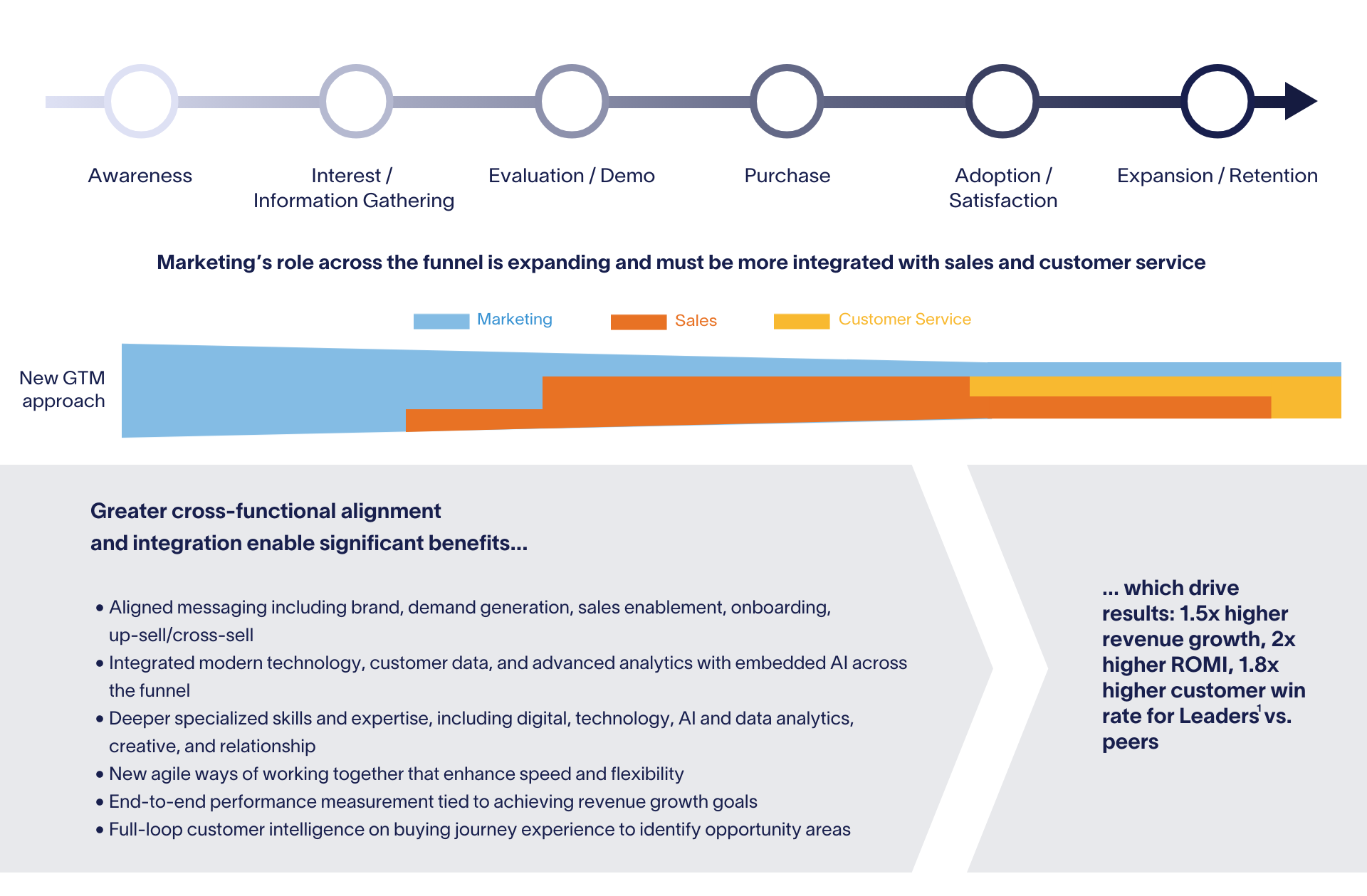B2B go-to-market (GTM) is undergoing a significant transformation, and not everyone will catch up. Customer preferences continue to shift towards digital-first, self-service buyer journeys, and AI adoption is accelerating. In this rapidly changing environment, a small group of Leaders is developing advanced GTM capabilities that integrate digital tools, AI, and cross-functional coordination to deliver measurable results, distinguishing themselves from their peers.
Altman Solon’s 2025 B2B Digital GTM Study surveyed 202 GTM executives at telecommunications and technology companies in North America and Europe. We complemented our findings with in-depth discussions with 25 senior executives.
B2B GTM is at an inflection point
Our study confirmed the pace of GTM transformation is accelerating, with Leaders demonstrating stronger return on marketing investment (ROMI). These Leaders report:
- 1.5 times higher revenue growth.
- 2 times return on marketing investment.
- 1.8 times higher large-customer win rates.
These results are the consequences of cross-functional alignments, deploying advanced marketing technology tools, and applying AI to enable personalization, automation, and improved decision-making across multiple complex digital journeys.
The GTM Accelerator: a new operating model
These Leaders, making up 17% of the sample, have implemented what we call a GTM Accelerator. This operating model integrates strategy, technology, data, brand, and demand generation to support seamless customer experiences and stronger cross-functional collaboration.
Companies deploying this model are more likely to:
- View brand marketing as critical to growth.
- Use AI in advanced, performance-driving ways.
- Effectively measure GTM performance across brand and demand.
- Align marketing, sales, and customer service around shared objectives.
AI adoption is still early, but impactful in some cases
Our findings showed that most companies are still in the early phases of AI adoption, with tools being used for efficiency gains. We observed that many companies cited internal challenges, like fragmented systems, talent gaps, and risk aversion, as barriers to more ambitious AI integration. And yet, we observed a clear connection between the deployment of advanced AI and commercial impact. Leaders use AI for predictive analytics, account-based marketing (ABM), and real-time personalization, supported by integrated data and technology stacks. While the risks of highly integrated AI tools are real— from internal employee resistance to data security concerns to AI-generated content reading as "inauthentic"— the benefits can be substantial.
Brand marketing as a growth driver
One of the study’s key findings is the continued underinvestment in brand marketing relative to demand generation. Leaders represent an exception: brand is viewed as foundational to long-term performance (83% of Leaders compared to 51% of Laggards). Companies with mature brand marketing capabilities are significantly more likely to report improvements in revenue growth, brand awareness, and customer engagement.
The findings suggest that aligning brand and demand efforts, while applying more rigorous measurement to both can unlock substantial value.
Four challenges holding companies back
The study identifies four persistent challenges that limit GTM maturity:
- Limited alignment across marketing, sales, and customer service.
- Incomplete integration of technology and customer data.
- Imbalanced investment in demand vs. brand.
- Difficulty measuring marketing performance and impact.
Addressing these challenges often requires not only new capabilities but new ways of working and cross-functional governance models.
GTM Accelerators may vary, but performance is high
We studied several companies across enterprise software, telcos, and SaaS that implemented GTM Accelerators. We found that there is no one-size-fits-all modality. GTM Accelerators range from centers of excellence (COE) to shared service centers (SSC) or innovation hubs. Despite these differences in approach, the results achieved were overwhelmingly positive and include:
- ABM and AI-enabled insights leading to a threefold increase in unique site visits and a 50% increase in average deal size for top accounts.
- Integrated brand and demand strategies resulting in improved upselling and cross-selling, leading to a 20% increase in revenue.
- The implementation of predictive analytics and centralized revenue operations, yielding 40% year-over-year revenue growth.
Altman Solon partners with companies across the TMT landscape to help evaluate GTM maturity, build alignment across sales, marketing, and customer services, and launch initiatives that improve GTM capabilities and drive results.
Download the full whitepaper for a detailed look at:
- Trends reshaping B2B GTM (and what’s signal vs. noise in AI)
- The four obstacles blocking GTM maturity
- The GTM Accelerator: how Leaders integrate brand, demand, data, and AI
- Benchmarks and case evidence you can adapt now









